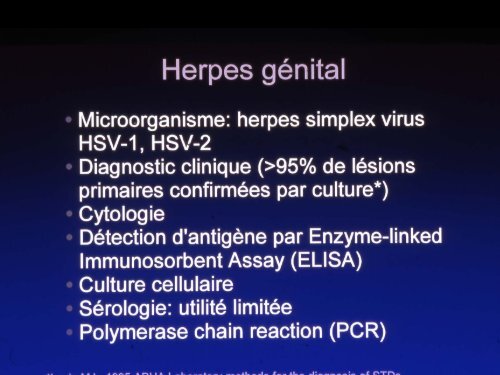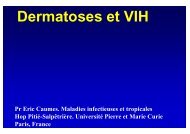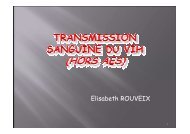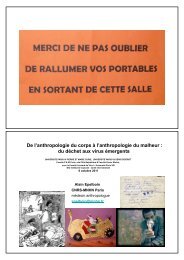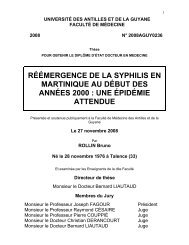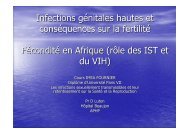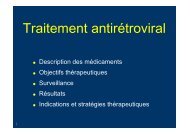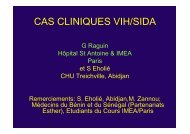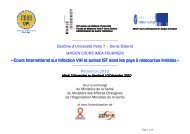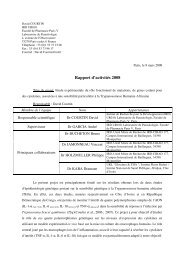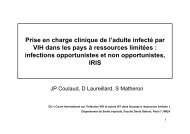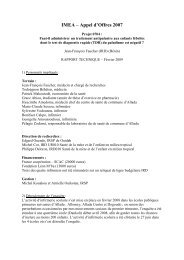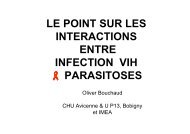HSV-2 = 50% - IMEA
HSV-2 = 50% - IMEA
HSV-2 = 50% - IMEA
Create successful ePaper yourself
Turn your PDF publications into a flip-book with our unique Google optimized e-Paper software.
Epidémiologie de l ’infection à <strong>HSV</strong>2
Estimated Prevalence of STDs in the US<br />
1 Million New Genital Herpes Infections per Year in the US<br />
HPV<br />
20 million<br />
Chlamydia<br />
3 million<br />
Hepatitis B<br />
1.25 million<br />
HIV<br />
1.2 million<br />
Genital Herpes<br />
50 million<br />
1 in Every 5 adult Americans are Infected with Genital Herpes<br />
References:<br />
Centers for Disease Control and Prevention Web site. Available at: www.cdc.gov. Accessed August 10, 2006.<br />
Xu F et al. JAMA. 2006;296:964-973.<br />
U.S. Census Bureau Web site. Available at: http://www.census.gov.
U.S.A.<br />
• NHANES II 76-80 16.4%<br />
• NHANES III 88-94 21.9%<br />
Augmentation de la séroprévalence de 30%<br />
France<br />
• HERPIMAX<br />
– 4412 sérums recueillis en 1996, population générale<br />
– femmes > 35 ans, hommes > 45 ans<br />
femmes 17.9%<br />
Séroprévalence globale 17.2%<br />
hommes 13.7%<br />
Johnson RE New Engl J Med. 1989<br />
Fleming DT. New Engl J Med. 1997<br />
Malkin JE. 39th Iccac San Francisco. 1999
Rachna Gupta, Terri Warren, Anna Wald. Genital Herpes. Lancet Infectious Diseases, 2007, 370, 2127-2136
Epidémiologie de l’infection à <strong>HSV</strong>-2<br />
en Afrique subsaharienne<br />
• Etudes séro-épidémiologiques<br />
– Devenues possibles gâce à la sérologie spécifique de type<br />
– Ouganda, Tanzanie, Zimbabwe, Afrique du Sud<br />
– Forte prévalence chez les jeunes :<br />
• Moins de 20 ans : 20-30%<br />
• Adultes jeunes : 60-80%<br />
• Femmes plus infectées que les hommes<br />
• Etiologies des ulcérations génitales (2001)<br />
– <strong>HSV</strong>-2 > Chancre mou > Syphilis<br />
• Excrétion génitale asymptomatique<br />
– Très peu de données<br />
– Femmes enceintes VIH+ au Kenya : 17% de portage cervical<br />
(Mostad et al. J Infect Dis 2000;181:58-63)
• Genital shedding of herpes simplex virus<br />
type 2 in childbearing-age and pregnant<br />
women living in Gabon<br />
Ozouaki F et al. Int J of STD & AIDS,2005
• 355 subjects recruited<br />
– blood and cervicovaginal samples collected<br />
• <strong>HSV</strong>2 seroprevalence : 65.9% increasing<br />
with age (peak within the range 35-39 y)<br />
• Prevalence of <strong>HSV</strong>2 DNA genital shedding<br />
was 13.8% on a single sampling episode
• This high prevalence of <strong>HSV</strong> 2 shedding may be<br />
associated with high risk of <strong>HSV</strong> 2 vertical<br />
transmission to neonates<br />
• Which in Africa may be higher than that observed<br />
in developed world due to :<br />
– high incidence of <strong>HSV</strong>2 infection<br />
– high fertility rates in African<br />
– high HIV prevalence young women
Cotonou<br />
HIV-1: 2.8% W, 2.8% M<br />
<strong>HSV</strong>-2: 30% W, 12% M<br />
Yaounde<br />
HIV-1: 7% W, 3.6% M<br />
<strong>HSV</strong>-2: 51% W, 27% M<br />
Kisumu<br />
HIV-1: 29% W, 18% M<br />
<strong>HSV</strong>-2: 68% W 35% M<br />
Ndola<br />
HIV-1: 32% W, 24% M<br />
<strong>HSV</strong>-2: 55% W, 36% M
Données séro épidémiologiques<br />
Grande variabilité géographique<br />
• Europe de l ’Ouest : 5 - 15%<br />
• U.S.A. : 20%<br />
• Afrique : 30 - 80%
Facteurs de risques<br />
• Age<br />
• Sexe féminin<br />
• Facteurs ajustés sur l ’âge<br />
– Nombre de partenaires sexuels<br />
– Age du premier rapport sexuel<br />
– Antécédents de MST<br />
– Niveau socio-économique faible<br />
Malkin JE. 38th ICCAC San Diego. 1998<br />
Fleming DT. New Engl J Med. 1997<br />
Wald A. Sex Transm Dis. 1997
Transmission<br />
• 144 couples sérodifférents <strong>HSV</strong>2<br />
– Taux annuel de transmission : 10%<br />
– 70% des cas de transmission survenus alors que le sujet<br />
source était asymptomatique<br />
– Différence liée au sexe<br />
• femme homme : 4.5%<br />
• homme femme : 19%<br />
• Suivi d ’une cohorte de 7046 femmes enceintes<br />
– Taux d ’acquisition de 33% pour <strong>HSV</strong>2 (4% pour <strong>HSV</strong>1)<br />
Mertz GJ. Ann Intern Med. 1992<br />
Brown ZA. N Engl J Med. 1997
• Transmission of Herpes Simplex Virus type 2<br />
among factory workers in Ethiopa<br />
Yenew Kebede et al. J of Infect Dis. 2004;190:365-372
• Retrospective study 1997-2002<br />
• 1612 subjects (including 133 heterosexual<br />
couples)<br />
• <strong>HSV</strong>2 seroprevalence at enrollment : 40.9%<br />
(female : 59.5 – male: 34.6) ; 43.4% 20-30 y
• 41 monogamous <strong>HSV</strong>2 serodiscordant couples<br />
– 12 with man <strong>HSV</strong>2 +<br />
– 29 with woman <strong>HSV</strong>2 +<br />
• <strong>HSV</strong>2 seroincidence was:<br />
– 20.7 seroconversions /100 PY in women<br />
– 4.9 seroconversions /100 PY in men
• Majority of <strong>HSV</strong>2 + subjects did not report any<br />
episode of genital ulcer (>90%)<br />
– symptoms are unnoticed and/or<br />
underreported<br />
– probable reason of the widespread dissemination of<br />
<strong>HSV</strong>2 infection
• Increasing relative prevalence of <strong>HSV</strong>2<br />
infection among men with genital ulcers<br />
from a mining community in South Africa<br />
Lai W et al. Sex Transm Infect. 2003;79:202-207
• <strong>HSV</strong>2 as a cause of GUD increased from<br />
17.2% to 36% between 1994 and 1998
Increasing role in HIV susceptibility attributed to <strong>HSV</strong>-2<br />
(c): Etiology of GUD (%)<br />
South Afr 94<br />
South Afr. 00<br />
Tanzania<br />
T pallidum<br />
30<br />
16.2<br />
15<br />
H ducreyi<br />
12<br />
24.5<br />
10<br />
<strong>HSV</strong><br />
9<br />
29.2<br />
45<br />
TP + HD<br />
8<br />
1.7<br />
TP + <strong>HSV</strong><br />
1<br />
1.1<br />
HD + <strong>HSV</strong><br />
4.8<br />
All 3 agents<br />
0.7<br />
Mixed no <strong>HSV</strong><br />
2<br />
LGV<br />
3<br />
C. granulom.<br />
9<br />
2<br />
Indeterm.<br />
23<br />
21.7<br />
HIV Serop.<br />
40<br />
Vanmali et al. ICAAC, 2001/ Chen et al<br />
2000/O'Farell, 1994
Etiology of GUD in South Africa<br />
(1986-98)<br />
Chen CY, Ballard RC et al. Sex Transm Dis. 2000;27:21-29
Herpès génital chez des malades africains<br />
souffrant d’ulcération génitale : Evolution 1980-1999<br />
Pourcentage de <strong>HSV</strong>-2 isolé<br />
45<br />
40<br />
35<br />
30<br />
25<br />
20<br />
15<br />
10<br />
5<br />
0<br />
1980-84 1985-89 1990-94 1995-99<br />
Harare<br />
Durban-1<br />
Durban-2<br />
Afrique du Sud<br />
Rwanda<br />
Kenya<br />
D’après O’Farrell STI 1999
Rachna Gupta, Terri Warren, Anna Wald. Genital Herpes. Lancet Infectious Diseases, 2007, 370, 2127-2136
Primo infection<br />
Asymptomatique<br />
Symptomatique<br />
Latence<br />
Réponse immunitaire<br />
cellulaire et humorale<br />
Stimuli endo/exogènes<br />
Réactivation<br />
Asymptomatique Subclinique Symptomatique
Excrétion virale<br />
Contact<br />
cutanéo-muqueux<br />
Transmission<br />
Epidémiologie<br />
<strong>HSV</strong><br />
Facteurs Géographie Facteurs<br />
comportementaux<br />
socio-économiques
Asymptomatiques<br />
vrais<br />
Symptomatiques<br />
diagnostiqués<br />
20%<br />
20%<br />
60%<br />
Symptomatiques<br />
non diagnostiqués<br />
CoreyL. Sex Transm Dis. 1994
Jean-Elie<br />
Malkin, , Cours IST, <strong>IMEA</strong>
Jean-Elie<br />
Malkin, , Cours IST, <strong>IMEA</strong>
Jean-Elie<br />
Malkin, , Cours IST, <strong>IMEA</strong>
Jean-Elie<br />
Malkin, , Cours IST, <strong>IMEA</strong>
Jean-Elie<br />
Malkin, , Cours IST, <strong>IMEA</strong>
Bruno Halioua, , Institut Alfred Fournier
Bruno Halioua, , Institut Alfred Fournier
Diagnostic<br />
Direct<br />
Indirect<br />
mise en évidence du virus<br />
par prélèvement du liquide contenu<br />
dans les vésicules ou érosions fraîches<br />
< 3 jours<br />
•Culture<br />
•Détection des antigènes<br />
•PCR<br />
détection des anticorps<br />
dirigés contre le virus<br />
par prise de sang<br />
•Sérologie
Diagnostic direct :<br />
la culture<br />
C’est la technique de référence<br />
Résultats en 1 à 5 jours<br />
Spécificité +++
Diagnostic indirect : La sérologie<br />
Renseigne sur l’état d’immunité du sujet vis-à-vis<br />
de l ’<strong>HSV</strong><br />
De nombreux tests sont disponibles (Elisa ++)<br />
Possibilité de tests spécifiques de type (trousses)<br />
Est utile principalement pour les études épidémiologiques<br />
Grand progrès dans la sensibilité mais encore des faux<br />
négatifs (près de 5 %)<br />
Dans le diagnostic intérêt pour documenter une<br />
primo-infection
Increasing role in HIV susceptibility attributed<br />
to <strong>HSV</strong>-2 (a)<br />
• 31 studies of <strong>HSV</strong>-2 seropositive have RR=2.1<br />
of HIV infection when herpes precedes HIV<br />
• Among <strong>HSV</strong>-2 sero + persons, 52% of ST HIV<br />
infection attributed to <strong>HSV</strong><br />
• Population attributable risk % varies with <strong>HSV</strong><br />
seroprevalence: 19% for the ST-HIV infection in<br />
the general pop (<strong>HSV</strong> seroprev=22%) and <strong>50%</strong><br />
for ST HIV in CSWs (<strong>HSV</strong> seroprev=80%)<br />
Wad. A et al. J Infect Dis, 2002, 185, 45-52)
Wald A. JID: 2002;185:45-52<br />
<strong>HSV</strong>-2 and HIV acquisition<br />
meta-analysis:<br />
Risk of HIV infection<br />
in <strong>HSV</strong>-2 infected<br />
persons:<br />
A: 9 Longitudinal &<br />
nested case-control<br />
studies:<br />
RR=2.1 (1.4-3.2)<br />
B: 22 Case-control &<br />
cross sectional<br />
studies:<br />
OR=3.9 (3.1-5.1)
Synergistic Link Between HIV and <strong>HSV</strong>-2<br />
• <strong>HSV</strong>-2 increases risk of acquiring HIV by<br />
approximately 3-fold 1<br />
– mucosal barrier breakage may increase susceptibility<br />
to HIV 2<br />
– <strong>HSV</strong>-2 results in an influx of activated CD4 + T cells<br />
and macrophages into genital mucosa and skin 3<br />
– HIV viral replication is increased by <strong>HSV</strong>-2 reactivation<br />
and/or shedding 4,5<br />
• HIV can worsen the clinical and subclinical<br />
manifestations of <strong>HSV</strong>-2 6-8<br />
1. Freeman EE, et al. AIDS. 2006;20:73-83. 5. Schacker T, et al. J Infect Dis. 2002;186:1718-1725.<br />
2. Weiss H. Herpes. 2004;11(suppl 1):24A-35A. 6. Schacker T, et al. J Infect Dis. 1998;178:1616-1622.<br />
3. Koelle DM, et al. J Infect Dis. 1994;169:956-961. 7. Corey L, et al. J Acquir Immune Defic Syndr. 2004;35:435-445.<br />
4. Mole L, et al. J Infect Dis. 1997;176:766-770. 8. Posavad CM, et al. J Infect Dis. 2004;190:693-696.
The Majority of HIV+ Patients Are<br />
Infected With <strong>HSV</strong>-2<br />
HIV + Population<br />
>1 Million Patients 1<br />
• 60%-70% of HIV +<br />
patients in the<br />
US are also<br />
HIV and <strong>HSV</strong>-2<br />
HIV only<br />
infected with<br />
<strong>HSV</strong>-2 2,3<br />
1. Centers for Disease Control and Prevention. Available at: http://www.cdc.gov. Accessed November 14, 2006.<br />
2. Meyer JL, et al. Sex Transm Infect. 2005;81:309-315.<br />
3. Hook EW, et al. J Infect Dis. 1992;165:251-255.
Model Suggests a Significant Proportion of<br />
HIV in the US May Be Attributed to <strong>HSV</strong>-2 *<br />
• Among <strong>HSV</strong>-2-seropositive persons, an estimated 52% of sexually<br />
transmitted HIV-1 infections may be attributed to <strong>HSV</strong>-2 infections<br />
MSM (<strong>HSV</strong>-2 = <strong>50%</strong>)<br />
†<br />
35%<br />
African Americans<br />
(<strong>HSV</strong>-2 = <strong>50%</strong>) †<br />
35%<br />
US Overall<br />
Population<br />
(<strong>HSV</strong>-2 = 22%) †<br />
19%<br />
HIV Infections Attributable<br />
to <strong>HSV</strong>-2<br />
Wald A and Link K. J Infect Dis. 2002;185:45-52.<br />
0 10 20 30 40 50 60 70 80 90 100<br />
%<br />
MSM = men who have sex with men<br />
* Population attributable risk is a calculated value<br />
†<br />
The numbers in parentheses refer to the proportion of the specified population that is <strong>HSV</strong>-2 seropositive
D Serwadda, M Wawer, R Gray, N Swandambo, Population-based research on a very clever virus. CROI, Febr 2008
Ronald Gray, M.D. Reducing HIV transmission: Lessons Reducing HIV transmission: Lessons from Rakai and other<br />
African from Rakai and other African studies. IAS, Rio de Janeiro, 2005
D Serwadda, M Wawer, R Gray, N Swandambo, Population-based research on a very clever virus. CROI, Febr 2008
Marie Laga, The synergy between Prevention and Care in Africa. IAS, Rio de Janeiro, 2005
Elevated Rates of <strong>HSV</strong>-2 Shedding * Persist<br />
in HIV + Patients Treated With HAART<br />
40<br />
30<br />
20<br />
10<br />
0<br />
15<br />
10<br />
Days of Mucosal <strong>HSV</strong> Shedding<br />
(median %)<br />
18<br />
HAART-Treated<br />
29<br />
Untreated<br />
Days With <strong>HSV</strong> Lesions (median %)<br />
11.3<br />
P=0.08<br />
P=0.001<br />
• 28 HAART-treated and 49<br />
untreated subjects with HIV<br />
and <strong>HSV</strong>-2 evaluated to<br />
determine number of days<br />
with shedding and lesions<br />
• No significant difference on<br />
HAART for shedding or <strong>HSV</strong><br />
DNA level<br />
• Significantly fewer days with<br />
<strong>HSV</strong> lesions on HAART<br />
5<br />
0<br />
2.8<br />
HAART-Treated<br />
Untreated<br />
Posavad CM, et al. J Infect Dis. 2004;190:693-696.
12<br />
10<br />
8<br />
Asymptomatic* <strong>HSV</strong>-2 Shedding Is<br />
Common Among HIV + Patients †<br />
Percent of Days With Shedding<br />
9.7%<br />
80<br />
70<br />
60<br />
50<br />
Percent of Shedding Days That<br />
Were Asymptomatic<br />
68%<br />
6<br />
4<br />
3.1%<br />
40<br />
30<br />
20<br />
33%<br />
2<br />
10<br />
0<br />
Neg<br />
HIV MSM<br />
Pos<br />
HIV MSM<br />
0<br />
HIV − MSM<br />
HIV + MSM<br />
(n=13)<br />
(n=68)<br />
(n=13)<br />
(n=68)<br />
*Shedding in the absence of lesions. The clinical significance of <strong>HSV</strong>-2 shedding is unknown<br />
†<br />
Data from patients not receiving HAART; based on results of <strong>HSV</strong>-2 viral culture<br />
Schacker T, et al. J Infect Dis. 1998;178:1616-1622.<br />
MSM = men who have sex with men
le<br />
meilleur<br />
…de CROI 2008<br />
Un traitement par aciclovir chez des sujets VIH-,<br />
<strong>HSV</strong>-2+ ne diminue pas le risque d'infection par le VIH<br />
7<br />
Traitement anti-<strong>HSV</strong>-2 à visée<br />
de prévention du VIH<br />
Aciclovir<br />
400 mg bid<br />
n = 1 637<br />
Femmes VIH- <strong>HSV</strong>-2+<br />
hétérosexuelles<br />
et<br />
Hommes<br />
Homosexuels<br />
VIH- <strong>HSV</strong>-2+<br />
Randomisation<br />
Placebo bid<br />
n = 1 640<br />
Critère de jugement principal :<br />
acquisition du VIH<br />
Survie sans VIH<br />
1,0<br />
0,9<br />
0,8<br />
0,7<br />
0,6<br />
0,5<br />
0<br />
Temps avant infection à VIH<br />
3<br />
6<br />
Placebo<br />
Aciclovir<br />
9<br />
Mois<br />
12<br />
p = 0,39<br />
15<br />
18<br />
Celum C, CROI 2008, Abs. 32LB
Connie Celum, HPTN III randomized, placebo control trial of acyclovir for reduction of HIV acquisition among high risk <strong>HSV</strong> 2 seropositive HIV neg persons, CROI, Febr 2008
Connie Celum, HPTN III randomized, placebo control trial of acyclovir for reduction of HIV acquisition among high risk <strong>HSV</strong> 2 seropositive HIV neg persons, CROI, Febr 2008
Connie Celum, HPTN III randomized, placebo control trial of acyclovir for reduction of HIV acquisition among high risk <strong>HSV</strong> 2 seropositive HIV neg persons, CROI, Febr 2008
Connie Celum, HPTN III randomized, placebo control trial of acyclovir for reduction of HIV acquisition among high risk <strong>HSV</strong> 2 seropositive HIV neg persons, CROI, Febr 2008
HERPES GENITAL<br />
First Clinical Episode<br />
Acyclovir 400 mg orally three times a day for 7--10 days,<br />
OR<br />
Acyclovir 200 mg orally five times a day for 7--10 days,<br />
OR<br />
Famciclovir 250 mg orally three times a day for 7--10<br />
days,<br />
OR<br />
Valacyclovir 1 g orally twice a day for 7--10 days.<br />
(CDC, 2006,WHO, 2004)
HERPES GENITAL<br />
Episodic Therapy for Recurrent<br />
Herpes<br />
Acyclovir 400 mg orally three times a day for 5 days*,<br />
OR<br />
Acyclovir 200 mg orally five times a day for 5 days*,<br />
OR<br />
Acyclovir 800 mg orally twice a day for 5 days*,<br />
OR<br />
Famciclovir 125 mg orally twice a day for 5 days*,<br />
OR<br />
Valacyclovir 500 mg orally twice a day for 3--5 days*,<br />
OR<br />
Valacyclovir 1.0 g orally once a day for 5 days*.<br />
(5-10 days if HIV+, CDC)<br />
(CDC, 2006,WHO, 2004)
HERPES GENITAL<br />
Suppressive Therapy for<br />
Recurrent Herpes<br />
Acyclovir 400 mg orally twice a day,<br />
OR<br />
Famciclovir 250 mg orally twice a day,<br />
OR<br />
Valacyclovir 500 mg orally once a day,<br />
OR<br />
Valacyclovir 1.0 gram orally once a day.<br />
(CDC, 2006,WHO, 2004)
HERPES GENITAL<br />
Suppressive Therapy for<br />
Recurrent Herpes if HIV+<br />
Acyclovir 400--800 mg orally twice to three times a day,<br />
OR<br />
Famciclovir 500 mg orally twice a day,<br />
OR<br />
Valacyclovir 500 mg orally twice a day.<br />
(CDC, 2006)
Suppressive treatment of recurrent genital<br />
herpes<br />
A meta-analysis<br />
(Lebrun-Vignes B, Bouzamoundo A, Dupuy A,<br />
Guillaume JC, Lechat Ph, Chosidow O)<br />
‣Immunocompetent patients, suppressive<br />
treatment of recurrent genital herpes, RCTs vs PBO<br />
‣ 14 RCTs (6158 patients)
Global analysis


